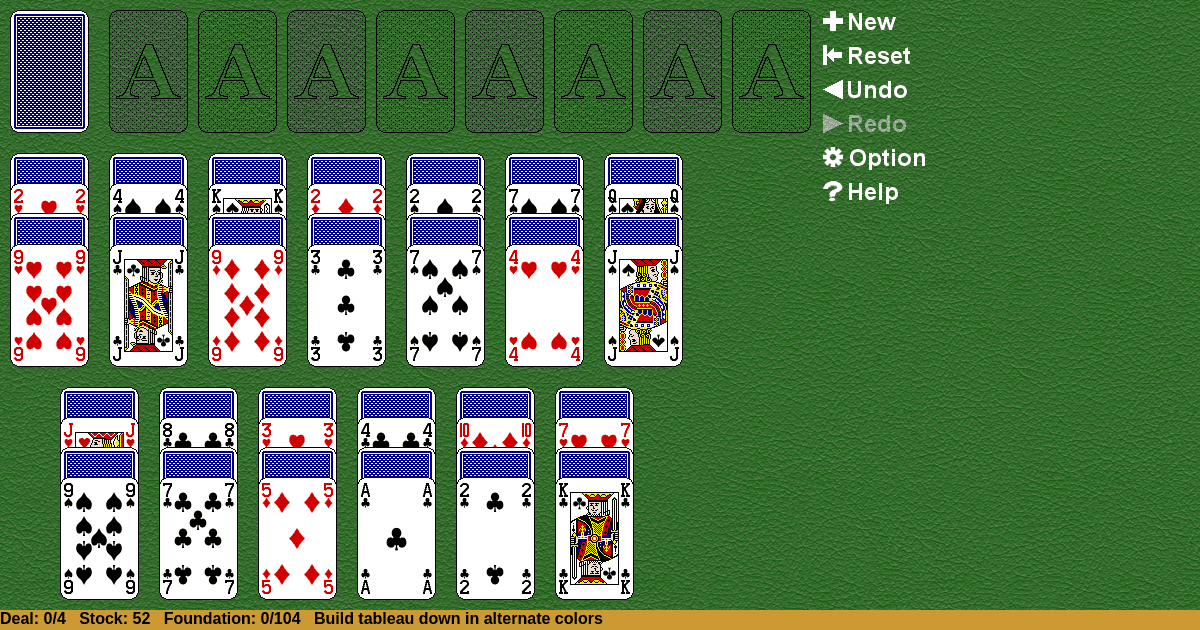Trillium
Home |
How to play |
FAQ |
About
How to play Trillium?
Game Objective:
The primary goal in Trillium Solitaire is to build all cards into the foundation piles in ascending order by suit, starting from Ace and ending with King for each suit.
Setup & Layout:
- Use a standard 52-card deck.
- Tableau: The tableau consists of 13 piles, each representing a column. Each pile receives 4 cards at the start of the game, dealt in an alternating pattern: the first card face up, the next face down, and so forth, so that each pile has a mix of face-up and face-down cards.
- Foundations: There are 4 foundation piles, one for each suit. All foundations start empty.
- Stock: Any remaining cards after the tableau setup form the stock pile, which is placed aside and used to introduce new cards into play.
- Waste: Cards from the stock that cannot be played immediately are placed in the waste pile, face up.
Trillium Solitaire Rules:
- Building on Tableau: Cards are built down in the tableau by suit. Only cards of the same suit and in descending order may be placed on each other (e.g., 8♠ on 9♠).
- Moving Cards: Only the top face-up card of each tableau pile, or a legal sequence of cards (descending and matching suit), may be moved to another tableau pile or to the foundations.
- Foundations: Foundations are built up by suit, starting from Ace and progressing to King (Ace, 2, 3, …, King).
- Spaces: Any empty tableau pile (a space) can be filled by any card or legal group of cards (not restricted to Kings as in Klondike).
- Stock & Waste: When no moves are available, cards are drawn from the stock pile. If a drawn card cannot be played, it is placed face up in the waste pile. Only the top card of the waste pile may be played.
Gameplay:
On each turn, the player may:
- Move any available face-up card or legal descending sequence by suit within the tableau.
- Move cards to the foundation piles if they follow the ascending order by suit.
- Fill empty tableau spaces with any card or legal sequence.
- Draw cards from the stock pile when no moves are available; place unplayable cards in the waste pile.
- Play the top card of the waste pile to the tableau or foundation if legal.
Introducing New Cards: Cards are introduced from the stock pile, one at a time. If the stock is exhausted, the waste pile may be recycled as a new stock, depending on variant rules.
No Legal Moves: If no moves are possible and the stock is depleted (and recycling is not permitted), the game ends.
Winning & Losing Conditions:
- Win Condition: The game is won when all cards are successfully built into the four foundation piles in ascending order by suit (Ace to King).
- Loss Condition: The game is lost (or unwinnable) if no legal moves remain and the stock pile is exhausted, with cards still remaining in the tableau or waste that cannot be moved to the foundations.
Special Rules & Edge Cases:
- Filling Spaces: Unlike Klondike Solitaire, any card or legal descending sequence by suit may fill an empty tableau space, not just Kings.
- Sequence Movement: Only sequences that are in strict descending order and of the same suit may be moved as a group.
- Stock Recycling: Some variants allow recycling the waste pile back into the stock when exhausted; check specific house rules or software implementation for details.
- Multiple Moves: There is no restriction on the number of moves per turn; players may rearrange the tableau as long as all moves are legal.
Key Definitions:
- Tableau: The main play area consisting of 13 piles where cards are arranged and manipulated.
- Foundation: Four piles (one per suit) where cards are built up from Ace to King.
- Stock: The remaining undealt cards, used to introduce new cards into play.
- Waste: A pile for unplayable cards drawn from the stock.
This guide is based on the most authoritative available rules for Trillium Solitaire, a Spider variant with a 13x4 tableau and flexible space-filling rules.

Solitaire Collection
About Trillium
Rate (Trillium)
4.7 / 5
1,916 votes



























































